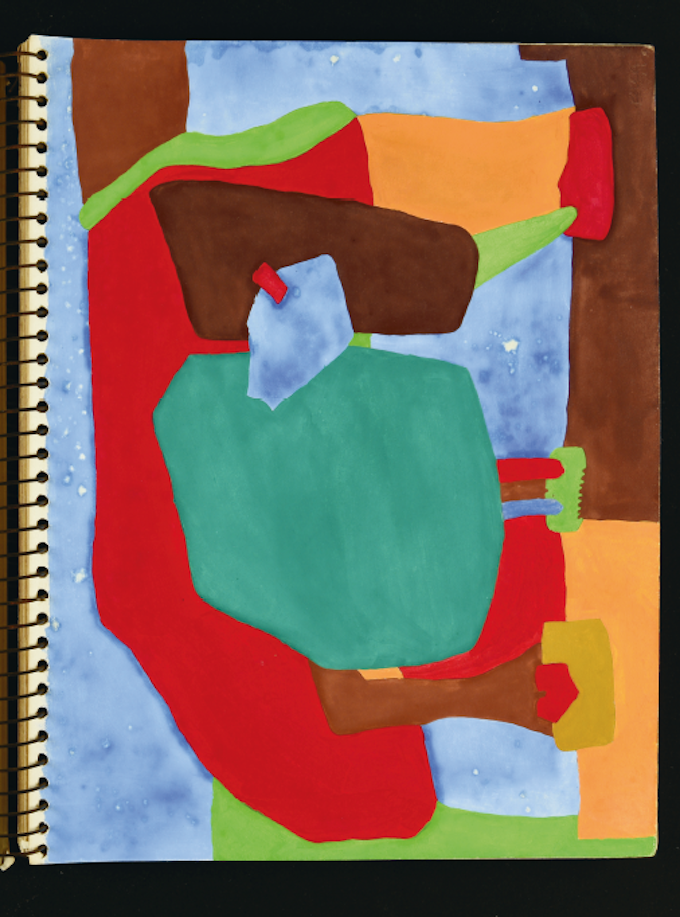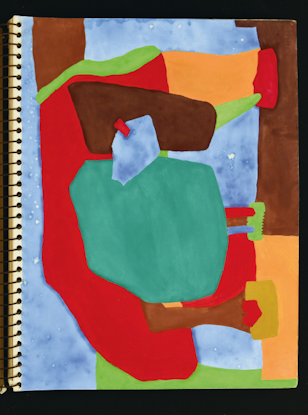
I will begin with a notebook dated 1981, which Lee Wen kept while studying abroad in Canada and the US, populated with anx-ious, fantastical figures: a character poking at its right eye with its right index finger; strange and anthropomorphic shapes; body parts and ambiguous objects with stalactite extensions racing across space and ready to strike; labyrinthine lines wrapping around themselves, melancholic and deflated. Lee Wen was in his twenties and struggling to find direction. He was the youngest of five children who had been raised by his single mother, Lee Mee Lan, after the death of his father, the writer Lee Xue Min, when the children were still young. The notebook is laden with descriptions of periods of depres-sion and insomnia – constant self-questioning about whether and how to be an artist, his exploration of how to combine visual art (what he calls ‘doodlings’ and ‘animation work’) with his love of music and writing.01
In between the pages of angst and homesickness, we see eruptions of determ-ination and excitement. In a note from 6 December 1981, the young Lee Wen declares:
Action in is the expression of the self Without expression-action can the self be?
He was drawing and painting a world of aliens and alter egos on the verge of – but not quite breaking beyond – the page, iterations of the same and yet different wandering subject: what is the self? What is art?
Born in 1957, Lee Wen came of age at a time when Singapore was undergoing the turbulent and uncertain process of nation-building – from a former British colony to a brief federation that formed Malaysia, and then rapid modernisation as a republic. The traumatic transformation was led by a state that dispensed democracy in highly regulated social and economic policies, as exemplified in the modernist public housing estates that replaced the social and familial fabric of old neighbourhoods with the contained discreteness of urban life. This razing of history led artists to question the clean slate that had been handed to them, and to dig beneath the veneer of nostalgia and order.02
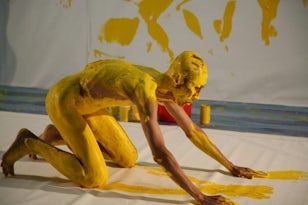
For many artists of Lee Wen’s genera-tion, the histories they had to confront were both familiar and alien, and in art history the spectre was the dominance of painting. The 1938 founding of the Nanyang Academy of Fine Arts set the tone for that legacy – with faculty trained in the Shanghai Academy model of Chinese ink painting and the School of Paris branch of European academic paint-ing. Painters in Singapore developed what became known as the Nanyang School as they sought to forge a regional style that in its nomenclature, ‘South Seas’, locates the then still-British colony in relation to China but also as a dispersion of its history. This com-mingling of antagonistic, imperial histories created identities that oscillated between Post-Impressionist oil paintings and a much longer and perhaps even more overwhelm-ing tradition of ink paintings.03
The Ever Present Past
In his essay on painting, artist Ho Tzu Nyen notes how the spectre of tradition hovers over every painter:
The activity of painting never begins upon a clean slate, for a piece of canvas is always scarred by traces of every other already made, populated as it is by a legion of readymade images, conventions and clichés. Holed up in his studio, the painter is nevertheless never solitary, for he is perpetually haunted by the names of every painter in history.04
If painting and, by extension, every artwork is a readymade, then the notion of the artist as genius has no ground. This idea certainly would have produced paralysis for many an aspiring and self-reflexive artist schooled in the Western myth of origins and originality. The ever present readymade also posed a dilemma for artists working in a place like Singapore where the search for identity was critical and yet ever deferred by the violence of colonial exploitation and the postcolonial modernising rupture from history. The clear tenets of figure/ground and paint/support could not address the instability of the modernising project for those artists who sought to uncover what the state worked to dismantle.
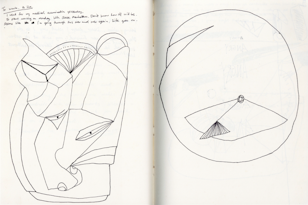
Such disturbance and rupture demanded new ways of making sense of the world, and performance art came to provide a mediating force for the social, political and aesthetic. Ray Langenbach has noted how
‘performance art – one variety of modernist aesthetic ritual, found in urban, industrial or post-industrial societies – seems to flourish in times of social disruption, instability and rapid social change’. 05 One of the most influential figures for the development of performance art in Singapore in the 1980s and 1990s was Tang Da Wu. After nine years abroad, he had returned to Singapore and was struck by how the landscape had changed with most of the villages replaced by urban developments. Out of that visit came Gully Curtains (1979), seven white curtains that he hung for three months at a site that had been bulldozed. The earthworks recorded the deterioration of the land, the monsoons and the scorching sun. The project upended the conventions of painting by taking the canvas off the frame and letting it swing from a rope in the open air, replacing the hand-held brush with the unpredictability of nature, and blurring the lines between painting and sculpture in form and material. The collapsing of subject and medium marked a shift in the obsession with landscape painting in Singapore, and the advent of something new. For Lee Wen, the search for why art mattered would see him experimenting with everything from drawing to painting and then performance art. Through beginning to understand line as motion and energy, he moved from the interior space of the self to the exterior space of the world. This essay proposes we trace that path through an examination of the artist’s notebooks and sketchbooks. However, this is not an argument for these media as more reliable sources of artistic intention or truthful interpretation instead of post-production documentation such as photographs and videos.
In her study of performance art, and the ontological possibilities afforded by live attendance and access to the artist and documentation, Amelia Jones reminds us that all forms of viewing and analysing are always already mediated by our personal and professional relationship to the artist; our discursive, visual and conceptual frameworks; and the local and larger historical contexts of the work. 06 Here the notebooks and sketchbooks are treated as media for the unfolding of the mind and interior life, to be reincarnated, or not, in the public staging of the performance.
Again and Again
Lee Wen is one among a generation of artists who have been instrumental in defining and shaping performance art in Asia, such as Chumpon Apisuk, Amanda Heng, Seiji Shimoda and Tr`ân Lu’o’ng. Upon graduating from Raffles Institution in Singapore, Lee Wen worked at various jobs, including as a bank officer for Chase Manhattan Bank. A drawing in the aforementioned 1981 notebook shows a face withdrawn into itself, the eyes narrow and despondent; the text above it reads:
To work, to live.
I went for my medical examination yesterday.
To start working on Monday. With Chase Manhattan. Don’t know how itll will be. Seems like I’m going through this over and over again. Life goes on.
In 1989, Lee Wen left his bank job and enrolled at LASALLE College of the Arts in Singapore to study fine arts. In addition to Tang Da Wu, his earliest influences were Joseph Beuys, Boris Nieslony and Alastair MacLennan.07 When Tang returned to live in Singapore again after two decades in London, he founded The Artists Village (TAV) in 1988. Lee Wen joined a year later and thrived with peers such as Vincent Leow, Amanda Heng, Juliana Yasin, Koh Nguang How, Han Sai Por, Chng Seok Tin, Wong Shih Yaw, Tang Mun Kit and Zai Kuning.08 Located in Sembawang, one of the last remaining farm areas in Singapore at the time, TAV fostered conversation, and work that was ephemeral, time-based, process-focussed, and collectively and socially informed. TAV would go on to become one of the most important collectives that nurtured and supported experimental art in an ecology that favoured painting and sculpture, and understood little of the practices of performance and installation.09 A year after joining TAV, Lee Wen studied at City College of London Polytechnic from 1990 to 1992, and later finished his Master of Fine Arts at LASALLE in 2006.
During his time in London, Lee Wen was often mistaken for a mainland Chinese person. This accentuated his questions about his identity and the purpose of art; his father was a well-known writer in the Chinese literary community in Singapore, but Lee Wen himself felt more comfortable in the English language and had been educated in a system born of British colonialism. Subjected to the homogenising gaze of Orientalism, Lee Wen embarked on a series of projects that developed alter egos he could use to address socially constructed ideas. The first of these projects is Journey of a Yellow Man. Developed for fifteen iterations (No.7, No.8, No.10, No.12, and No.14 were planned but not executed) from 1992 to 2001, Yellow Man had been in England, Singapore, India, Japan, Thailand, Mexico, Australia and China. The project evolved from a critique of Orientalism to a meditation on freedom, climate change, humility and religious prac-tices as responses to the locations in which Lee Wen performed. What started as an over-the-top, tongue-in-cheek response to an objectifying gaze imposed on the self, became a vehicle for the performer-subject to engage the audience-subject in questions about their cultural values and norms. Other embodied rewritings of histories and conventions in- clude: Ghost Stories (1992–2003), a series on fear and the anxieties of life in industrialised modernity; Anthropometry Revision (2008), an interrogation of Euro-American art his- tory through the work of Yves Klein; Strange Fruit (2003), an incarnation of Yellow Man in a cross-racial critique of colonial violence, with a nod to Billie Holiday’s haunting song of the same name; World Class Society (1999–2000), a satire of the state’s constant social policing and bureaucratisation of civil society in Singapore; and Ping Pong Go Round (1998 and 2012), a transformation of the ping-pong table into a round sculpture that allows players to move around and ques-tion the rules of engagement. Lee Wen’s projects cross genres, and he often writes poems, sings and plays the guitar, both as part of performances and as practices in their own right. 10
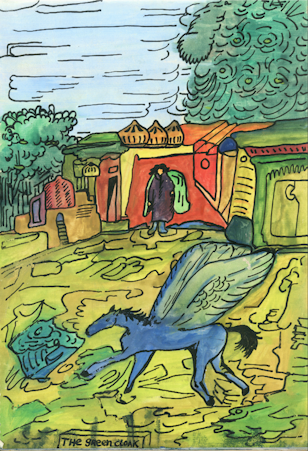
Parallel to his practice as a solo artist, he has been active in collectives – in particular Black Market International, Future of Imagination (FOI) and Rooted In The Ephemeral Speak (R.I.T.E.S.). He co-founded FOI in 2004, to test the Singapore National Arts Council’s loosening of its ten-year de facto ban on funding for performance art. The restriction had followed shortly after the state’s prosecution of Josef Ng for his performance Brother Cane (1993/1994), a response to the Singaporean police’s crackdown on establishments that cater to gay men.11 This controversy galvanised many artists, some of whom left Singapore to live and work in other countries. For Lee Wen, it solidified an approach that had drawn him to the work of Tang Da Wu and TAV – an understanding and commitment to art as social practice.
Back to Basics
The drawings in Lee Wen’s notebooks and sketchbooks from the 1970s and 1980s usually comprise diagonal and circular lines and forms. Some fill the whole page, like the tracings of a body moving outward into a room or given space. Shapes divide the page into planes and give the illusion of perspective and movement. A sketchbook dated 1978 is full of sculptural shapes overlapping one another, sometimes painted in blocks of yellow, green, red, purple, blue and brown. Clearly these are studies, akin to still lifes, of colour, form, volume and perspective. These shapes would manifest again in his performances later on, most obviously in the projects Yellow Man and Anthropometry Revision.
If we look at the early sculptural shapes in relation to the gouache paintings in a later sketchbook, such as The Land of Oblivion from 1987, we can discern a practice that has evolved from using colour to represent abstract and disembodied forms to using colour as expressive actions of the body – the social body and the landscape. A gouache landscape painting shows a human figure in the centre of the page with a cluster of small buildings to the right and back, and a winged horse moving toward the left in the foreground. A conventional depiction of figures within a landscape, the painting’s plane is divided into three sections. But here we see early on how Lee Wen’s use of lines indicates motion and energy – in the maze on the ground that forms the backdrop for the trotting winged horse, the swirls of leaves in the tree, the horizontals and curves of the clouds.
A few pages later, there is a portrait of a human figure with a head full of long, black hair and a face comprising blocks of yellow, brown, white, teal, purple and black. Reminiscent of traditional Chinese opera, in which actors and actresses wear heavy, exaggerated make-up, this figure occupies two-thirds of the page, as he seems to stare down at and past a field of flowers. This image is largely static, with a clear delineation between the space of the bearded figure and the space of nature.

This question of the place of the self and one’s relation to the bifurcated social and natural world would remain of central importance for Lee Wen’s work. One of his research interests during his studies was the genre of portraiture in Western art history and Chinese art history. He found that the former was full of examples of the human body as the focus of the work, whereas Chinese paintings tended to include the human, when they did, as an element of the landscape. As a young artist interrogating the purpose and possibilities of using the body as material, the question for him was how to make performance art – which had emerged in Europe, the US and Japan in the 1950s and 1960s – relevant for the context of Singapore and Southeast Asia.
Like his peers, Lee Wen would have to reimagine the foundations of academic art in order to open its vocabulary and techniques out towards a socially engaged practice. Dur-ing his studies at LASALLE, he undertook a rigorous study of how artists draw, how they use lines to convey emotions and rep-resent action. In a sketchbook from 1990, he wrote notes on the drawings of artists such as Giorgio de Chirico, Max Beckmann, Fernand Léger, Umberto Boccioni, Marcel Duchamp and Pablo Picasso:
Form is strongly suggested. Lines rendered in an urgent manner.
Geometric forms suggested in an objective manner. Dreamy landscape combined with scientific observation.
Age and authority. Nobility perhaps even wisdom.
Muscles and forms, juxtaposed planes, multi-facets, variety of levels
Tones rendered in a soft but dynamic effect. Dance-like
Lines and tones show a robotic mechanism. Marionettes & puppets suggested
Rustic feeling by free flowing brush strokes. Dance-like movements in a lively natural manner
Static tones, men & machines in an industrial, built environment depicted in a geometric manner.
Dynamic lines and tones showing vigour and energy.
If the line could suggest form, give the impression of a ‘dreamy landscape’ and show energy, line also could be used to simplify and eventually collapse the separation between figure and ground, portrait and landscape, the interior and the exterior. We see an example of this shift in a series of drawings of a Durga in a sketchbook from 1992. The study starts with a postcard image, which shows a Durga sitting on a patterned fur rug with an ox and staff behind him and mountains further in the background. In Lee Wen’s drawing, the planar divisions have been simplified, with only the Durga in the foreground and the mountains in the background. This Durga is sitting on a lotus flower, and the space between the foreground and the background is bridged through repetition – the curved, pointed shapes of the lotus petals are picked up in the gestural strokes that suggest the mountain peaks. In the same notebook, Lee Wen collapses figure and ground by blending the human body and the landscape. There is a building, an eye, a nose, the sun, a small animal, a tree, a mouth, a hand and horizontal and curved lines. The human body and the landscape are the same. This understanding would be crucial for Lee Wen’s approach to performance art – his conception of the body’s movement as the lines of a drawing and movement as an integration of the self into the world.
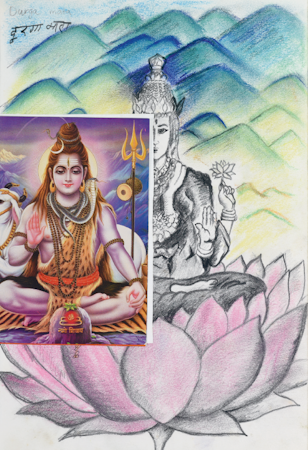
Lee Wen would see life’s processes and routines as line drawings, and line drawings as performative tracings of daily routines. Line, form and colour became vehicles for his performances on the interdependence of all aspects of life – human beings’ relationships with other parts of the natural world, the human world within the cosmic universe, the industrial world with its measurements of productivity, civility and socially sanctioned norms. His engagement with theory and praxis has been vast and ambitious;12 the disciplines of drawing and painting gave him the tools to embody the complicated with the clarity of line form colour action. As we trace his thought processes in his notebooks and sketchbooks, we see how this foundation shapes his understanding of performance as drawing, and how the studies on line, form and colour become studies on how to ‘fit’ his physical body into space. Lee Wen’s notebooks and sketchbooks open for us the future becoming, the readymade of the ever unfolding performance.
Footnotes
-
In collaboration with NTU Centre for Contemporary Art Singapore (NTU CCA Singapore), Asia Art Archive (AAA) started working with Lee Wen in 2017 to digitally archive his material. I would like to thank Lee Wen and Bruce Quek of Lee Wen Independent Archive; Ute Meta Bauer and Samantha Leong Min Yu of NTU CCA Singapore; and Elaine Lin, Hazel Kwok and Nicole Lai of AAA, for making this collective effort possible. In 2018, the National Gallery Singapore joined in supporting this project.
-
On how the modernising project led artists to rethink the purpose of art and the definition of contemporary art in Singapore, see C. J. W.-L. Wee, ‘Body and Communication: The “Ordinary” Art of Tang Da Wu’, Theatre Research International, vol.42, no.3, pp.286–306.
-
See Kwok Kian Chow, Channels & Confluences: A History of Singapore Art, Singapore: Singapore Art Museum, 1996; and Jeffrey Say and Seng Yu Jin (ed.), Histories, Practices, Interventions: A Reader in Singapore Contemporary Art, Singapore: Institute of Contemporary Arts Singapore, 2016.
-
Ho Tzu Nyen, ‘Perpetual Beginnings – Strands of Processes in Painting’, in Histories, Practices, Interventions, op. cit., p.295. The essay was originally published in Eugene Tan (ed.), Painting as Process: Re-evaluating Painting, Singapore: LASALLE-SIA College of the Arts, 2004, pp.15–27.
-
Ray Langenbach, ‘Looking Back at “Brother Cane”: Performance Art and State Performance’, in Histories, Practices, Interventions, op. cit. p.181. This essay was originally published in Lee Weng Choy (ed.), Space, Spaces and Spacing: The Substation Conference 1995, Singapore: The Substation, 1996.
-
Amelia Jones, ‘“Presence” in Absentia: Experiencing Performance as Documentation,’ Art Journal,vol.56, no.4, Winter 1997, pp.11–18.
-
Ning Chong, ‘Interview with Lee Wen’, The Artling [online magazine], 13 May 2014.
-
Lee Wen, ‘Performance Art in Context: A Singaporean Perspective’, master thesis, LASALLE-SIA College of the Arts, Singapore, May 2006, p.18.
-
The Artists Village was on private land, and the artists did not seek public entertainment licenses for their performances and exhibitions. The Land Authorities served TAV an eviction notice in 1989/1990. TAV unsuccessfully appealed to the agency and the newly formed National Arts Council; Lee Wen notes that he became suspicious of the Land Authorities’ motives when an officer mentioned media coverage of TAV events. See ibid., fn.46. See also Kwok Kian Woon and Lee Wen (ed.), The Artists Village: 20 Years On, Singapore: Singapore Art Museum, 2009; and The Artists Village, The Artists Village, Singapore 1988–1999, Singapore: The Artists Village, 1999.
-
See Khairuddin Hori, Lee Wen: Lucid Dreams in the Reverie of the Real, Singapore: Singapore Art Museum, 2012. See also Lee Wen, Anthropometry Revision, Singapore: SooBin Art Int’l, Chengdu: Red & Grey Art Contemporary, 2008.
-
Video documentation of Josef Ng’s performance Brother Cane (1993/1994) can be found in the Ray Langenbach Archive at Asia Art Archive.
-
Throughout the 1990s, he read extensively scholarship from a range of fields, such as political economy, postcolonial studies, Western art history, performance art, anthropology and theories of race. A notebook from 1999 shows his notes on Fredric Jameson, Herbert Marcuse, Friedrich Hegel, Francis Fukuyama, Alexandre Kojève, Theodor Adorno, Jun Ishikawa, Earnest Hooton, Carl Linnaeus and Jan Czekanowski. Another notebook from 2004 contains his notes on art history and theoretical studies of space and the body; he was reading texts such as Maurice Merleau-Ponty’s book On Phenomenology (19 45) and articles like Michael Fried’s ‘Art and Objecthood’ (1967) and Rosalind Krauss’s ‘Video: The Aesthetics of Narcissism’ (1976). These theoretical readings complemented his studies of the work of predecessors such as Carolee Schneeman, Yves Klein, Valie Export and Yoko Ono, and contemporaries such as Tr`ân Lu’o’ng, Mideo Cruz and W. Christawan.
